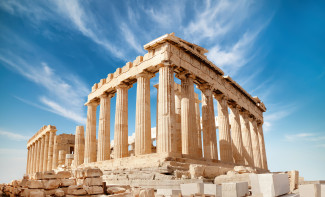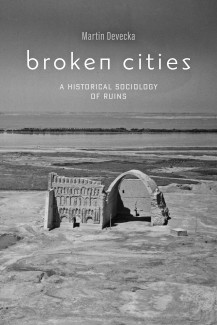
Johns Hopkins UniversityEst. 1876
America’s First Research University
Now Browsing:
Broken Cities: A Historical Sociology of Ruins

I wrote Broken Cities because I saw that ruins were being used to shape our view of the past and even to create the “pastness” of the past. As you can see by looking at the cover illustrations of any number of Classics monographs (including Broken Cities), ruins are potent symbols of an antiquity that is at the same time distant from us and, by way of various archaeological methods, reconstructible. I suspected that ruins had picked up these associations pretty recently, and I wondered how they might have signified at other times and places.
The answer, it turns out, is “differently,” and that’s one thing that Broken Cities tries to convey. In Augustan literature, for instance, ruination licenses the flight of Aeneas from Troy to Rome, a narrative pattern that Roman writers repeat when describing other ruins and other migrations. In the Qur’an, by contrast, ruins seem to mark the historical dead end of earlier societies that ignored the prophetic call. That’s one contrast among many between the numerous ways of ruin-gazing exposed by the four case studies that I treat in Broken Cities. Athens, Rome, Baghdad and Tenochtitlan: ruins look different everywhere.
They’re made differently, too. Part of my method in Broken Cities is to combine close study of literary evidence with historical and sociological analysis of the processes by which ruins emerge—or don’t emerge—in each civilization I investigate. This method led me to some startling discoveries. Classical Athens, for instance, is known to us as a ruin-obsessed culture: the Persian destruction of the city during Xerxes’ invasion, and Athens’ recovery after Xerxes’ defeat, form a kind of national mythology, bookended by anxieties about ruination that surrounded the possibility of a Spartan victory in the Peloponnesian War.

Yet the political framework of fifth-century Greece made ruins practically impossible. In a world of multiple rival city-states, any site that was wrecked and depopulated would soon be resettled, and no one had the political or military strength to keep a city empty. So, in the Classical Greek context, ruins were more of a representation than a reality—but no less an effective representation for all that. As part of Athenian collective memory, ruination helped produce Athenian unity and democracy; later on, in more vulnerable moments throughout the fourth century, oligarchs could conjure the image of ruins to show where the excesses of popular democracy might lead.
One thread that unites my four case studies is that, in each of them, ruins turn out to play an important role in debates about the future of cities. Far from being the neutral objects of an archaeological science, ruins are in every instance a politically live wire; the discourse surrounding ruins is a discourse about whether particular cities, or cities in general, are worth saving.
That observation leads me back to the modern situation that got me started on this project. The concept of ruins that archaeology has produced for us—as legible signs of a vanished antiquity—is one that can also be turned against modern cities, too. From 1980’s speculation about “dying cities” to last month’s tweets about how COVID has turned New York into a “ghost town,” depictions of ruined and empty American cities still form part of a right-wing anti-urban rhetoric that, by refusing to fund vital urban infrastructure, tries to bring about the ruins that it imagines. Broken Cities shows how this rhetoric has a long history: even as concepts of ruins differ wildly across time and cultures, the political utility of these concepts remains depressingly constant.
Order Broken Cities: A Historical Sociology of Ruins – published on September 1, 2020 – at the following link: https://jhupbooks.press.jhu.edu/title/broken-cities
Martin Devecka is an assistant professor of classical studies at the University of California, Santa Cruz. He is the author of Broken Cities: A Historical Sociology of Ruins.

The answer, it turns out, is “differently,” and that’s one thing that Broken Cities tries to convey. In Augustan literature, for instance, ruination licenses the flight of Aeneas from Troy to Rome, a narrative pattern that Roman writers repeat when describing other ruins and other migrations. In the Qur’an, by contrast, ruins seem to mark the historical dead end of earlier societies that ignored the prophetic call. That’s one contrast among many between the numerous ways of ruin-gazing exposed by the four case studies that I treat in Broken Cities. Athens, Rome, Baghdad and Tenochtitlan: ruins look different everywhere.
They’re made differently, too. Part of my method in Broken Cities is to combine close study of literary evidence with historical and sociological analysis of the processes by which ruins emerge—or don’t emerge—in each civilization I investigate. This method led me to some startling discoveries. Classical Athens, for instance, is known to us as a ruin-obsessed culture: the Persian destruction of the city during Xerxes’ invasion, and Athens’ recovery after Xerxes’ defeat, form a kind of national mythology, bookended by anxieties about ruination that surrounded the possibility of a Spartan victory in the Peloponnesian War.

Yet the political framework of fifth-century Greece made ruins practically impossible. In a world of multiple rival city-states, any site that was wrecked and depopulated would soon be resettled, and no one had the political or military strength to keep a city empty. So, in the Classical Greek context, ruins were more of a representation than a reality—but no less an effective representation for all that. As part of Athenian collective memory, ruination helped produce Athenian unity and democracy; later on, in more vulnerable moments throughout the fourth century, oligarchs could conjure the image of ruins to show where the excesses of popular democracy might lead.
One thread that unites my four case studies is that, in each of them, ruins turn out to play an important role in debates about the future of cities. Far from being the neutral objects of an archaeological science, ruins are in every instance a politically live wire; the discourse surrounding ruins is a discourse about whether particular cities, or cities in general, are worth saving.
That observation leads me back to the modern situation that got me started on this project. The concept of ruins that archaeology has produced for us—as legible signs of a vanished antiquity—is one that can also be turned against modern cities, too. From 1980’s speculation about “dying cities” to last month’s tweets about how COVID has turned New York into a “ghost town,” depictions of ruined and empty American cities still form part of a right-wing anti-urban rhetoric that, by refusing to fund vital urban infrastructure, tries to bring about the ruins that it imagines. Broken Cities shows how this rhetoric has a long history: even as concepts of ruins differ wildly across time and cultures, the political utility of these concepts remains depressingly constant.
Order Broken Cities: A Historical Sociology of Ruins – published on September 1, 2020 – at the following link: https://jhupbooks.press.jhu.edu/title/broken-cities
Martin Devecka is an assistant professor of classical studies at the University of California, Santa Cruz. He is the author of Broken Cities: A Historical Sociology of Ruins.

Login to View & Leave Comments
Login to View & Leave Comments


